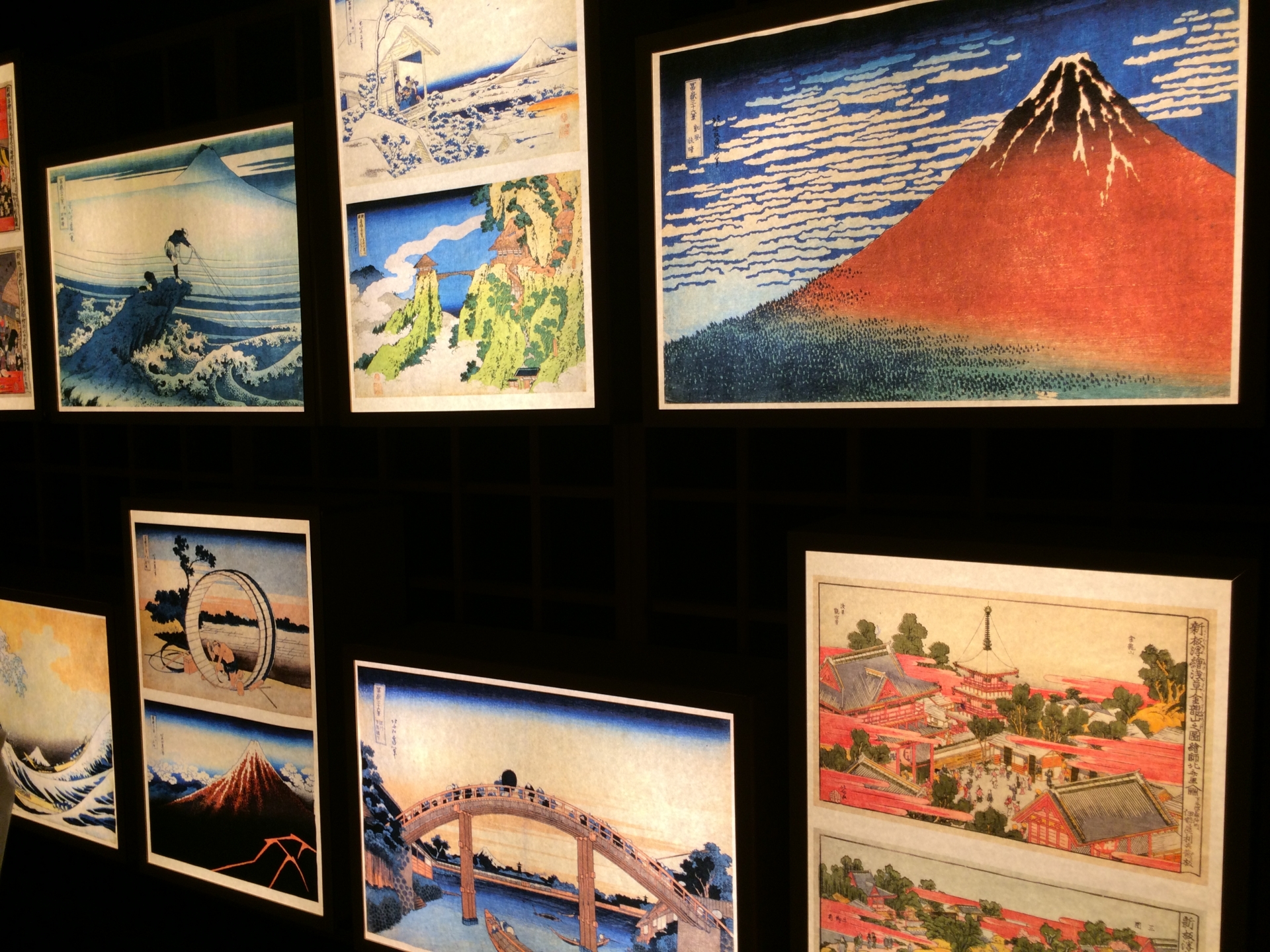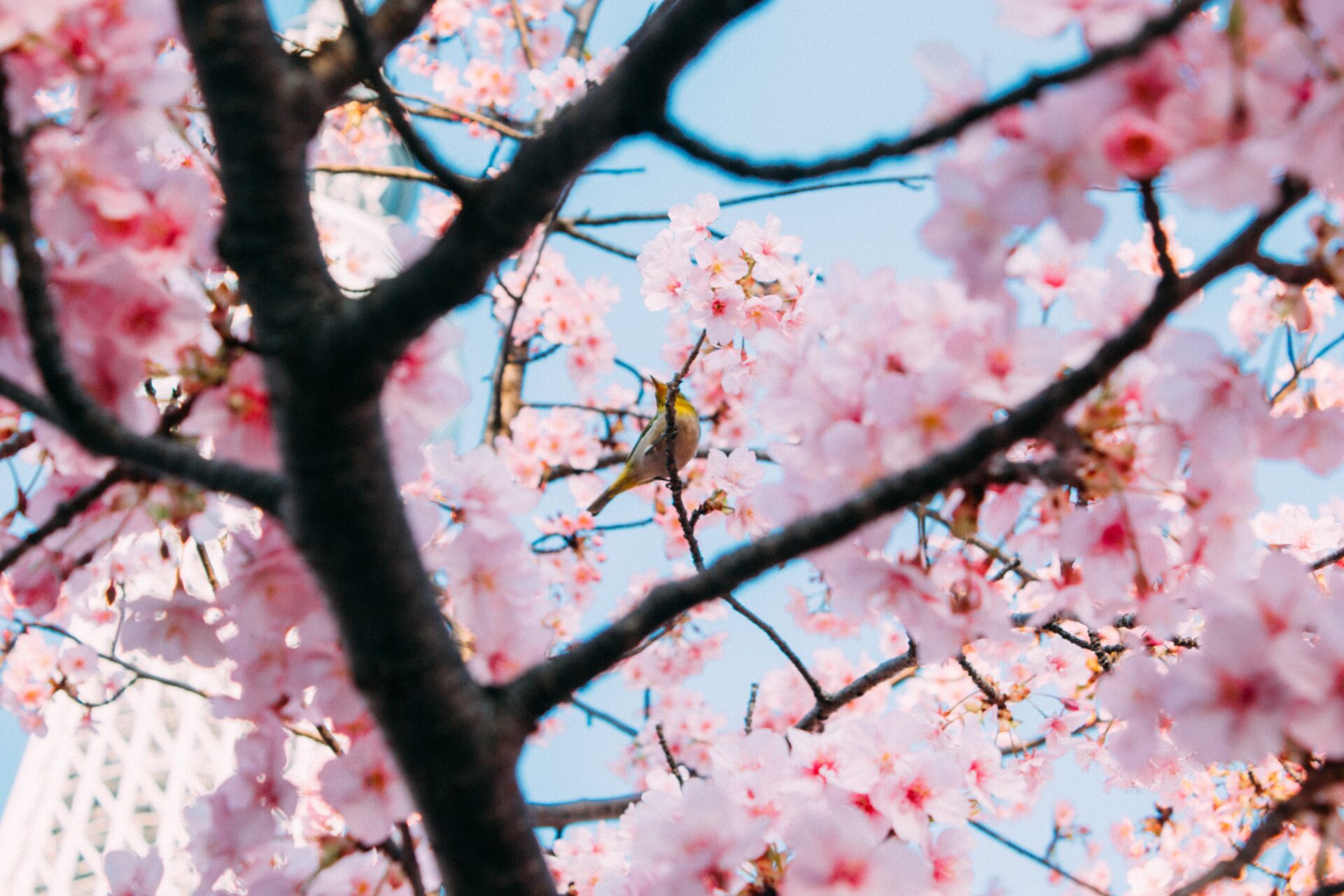What comes to your mind first when you think of “Japanese art”? Manga/anime? Traditional crafts like ironware and pottery? Or perhaps a peaceful Japanese garden? You can think of various topics but there is a genre of Japanese art that has a long history and is unique: Ukiyo-e (浮世絵). Japanese ukiyo-e paintings have various subjects depicted such as Mt.Fuji, local towns, and beauty, and have established an important painting culture in Japan. Let’s find out more about the charm of Ukiyo-e this time.
What is “Ukiyo-e”?
Ukiyo-e is a genre of Japanese art which originated in the early Edo period. Up until then, art and culture was something that was mainly inaccessible for the general citizens. In Japan, only privileged and upper-class citizens could come into contact with the art culture before the Edo period. However, during the Edo Period the lives of citizens improved as the whole country became more stable. As a result, a larger group of people came to enjoy art and paintings.
The term Ukiyo (浮世) is used to describe the aspects of urban life in culture during the Edo Period, especially in relation to entertainment. Ukiyo literally means ‘floating world’ and Ukiyo-e (浮世絵) are Japanese wood prints that often depict popular geisha, sumo wrestlers and Kabuki actors, beautiful landscapes like Mount Fuji, scenes from local folklore, flora and fauna and much more. Initially, ukiyo-e paintings were drawn one by one with hand drawing. But later, a wood blocking printing method was developed, which made it easy to publish thousands of ukiyo-e prints. Therefore, the price of one ukiyo-e print is said to be about one bowl of soba (¥300) at that time, and a larger number of people could afford to buy art. Today, ukiyo-e art plays a great role as an important material to learn their daily lives and culture of those days. Now, let’s look at some ukiyo-e artists from here.
1. Moronobu Hishikawa
Hishikawa Moronobu (菱川 師宣) was one of the ukiyo-e artists who lived in the 17th century, and established the genre of painting called “Ukiyo-e”. He is sometimes called “the founder of ukiyo-e”. Moronobu, who had been fond of drawing since he was little, learned painting techniques by himself. After he came to Edo, present Tokyo, he was asked to draw some illustrations for picture books, using woodcut style. Soon, his paintings became popular among the citizens of Edo. However, the books with woodcut illustrations came still a prize that not everyone could afford. Therefore, Moronobu started to produce a piece of woodblock illustrations as a form of “one painting”, and not just for illustrations for books. In this way he succeeded in spreading Ukiyo-e paintings to the public. Thanks to a woodblock print method, even normal people could afford to get a ukiyo-e print.
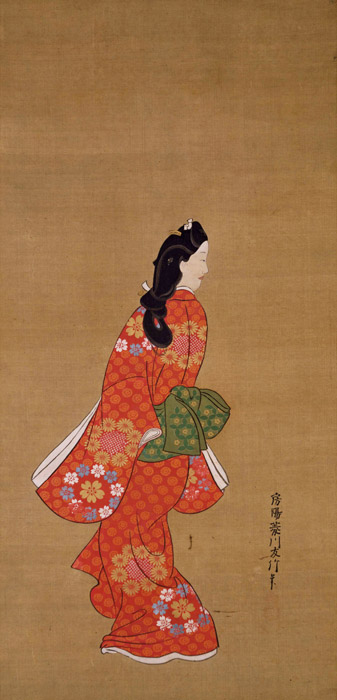
The above “Mikaeri Bijin” (見返り美人, Beauty Looking Back) is his representative ukiyo-e painting drawn by hand. It is an image of a woman in a red kimono trying to look back. A very famous ukiyo-e in Japan, and it was adopted as one of Japanese stamp designs in the past.
2. Hiroshige Utagawa
Hiroshige Utagawa (歌川 広重) was an ukiyo-e artist who lived from the end of the 18th century to the middle of the 19th century, and was good at landscape painting. His 55-figure series of “Tokaido Gojyuu-san tsugi” (東海道五十三次, the Fifty-three Stations of the Tokaido) became super popular among the common people of Edo.
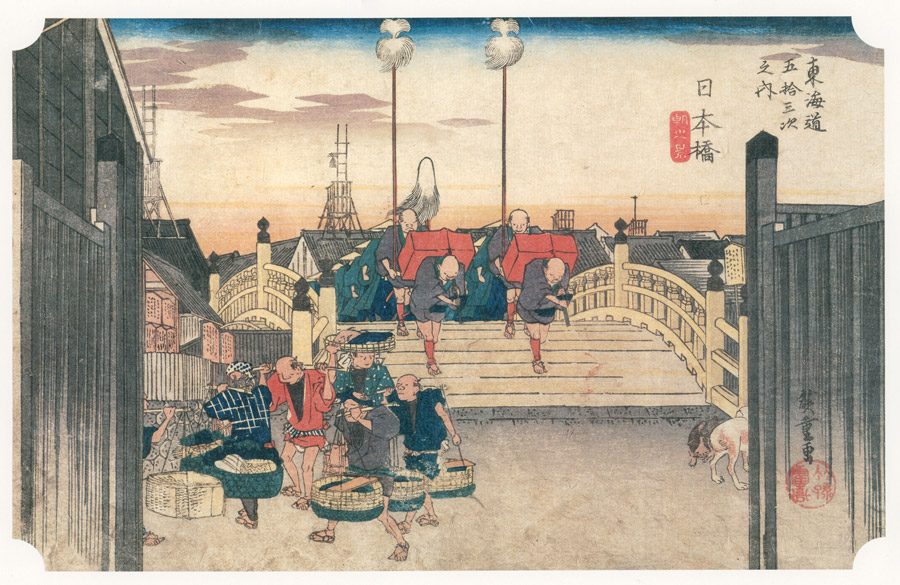
Among Hiroshige’s Fifty-three Stations of the Tokaido, “Nihonbashi Asa no kei” (日本橋 朝之景, Morning scene at Nihonbashi) is a particularly popular painting even now. It depicts well what Nihonbashi was like during the Edo period.
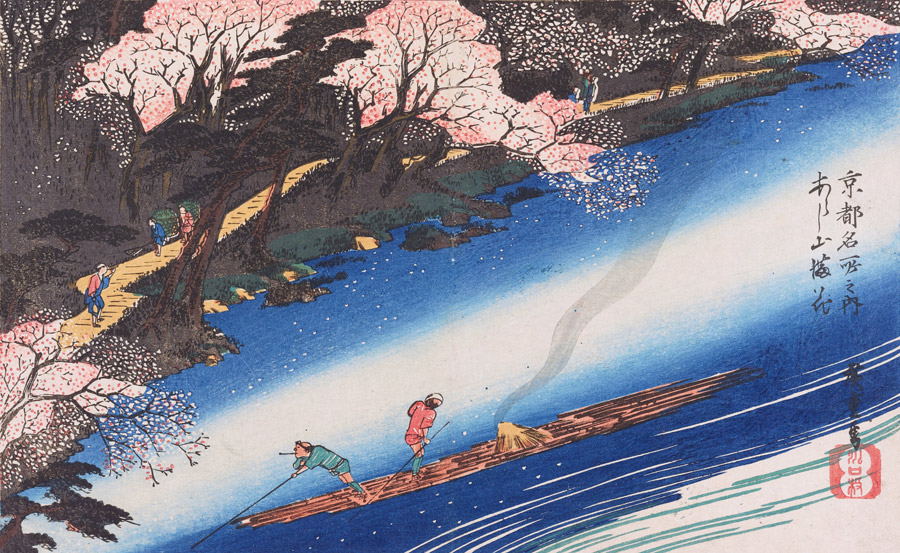
Hiroshige’s series of “Kyoto Meisho” (京都名所, Famous Places in Kyoto), depicting several famous places in Kyoto, has fascinated many people for centuries. “Arashiyama Manka” (嵐山満花, Full cherry blossoms at Arashiyama) is one of his popular works. This scene of two boatmen sailing down the river flowing through Arashiyama, with cherry blossoms in full bloom, is very romantic. By looking at the painting, you can understand that cherry blossoms have been loved among Japanese people for a long time.
3. Kuniyoshi Utagawa
Kuniyoshi Utagawa (歌川 国芳) was an ukiyo-e artist who lived in the same period as Hiroshige Utagawa, and was mainly good at “Musha-e” (武者絵, paintings of warriors and samurai). He is seen as one of the last great Ukiyo-e masters, however in his early years he was struggling to reach the larger public with his painting. In the 1820s he was commissioned with the paintings for a Chinese novel “Suikoden” (水滸伝, Water Margin). As luck would have it, this series became a bestseller among Edo citizens and Kuniyoshi’s became famous too. He started to draw Bushi characters of warriors appearing in the novel, vividly and robustly, which soon became a huge hit in Edo. Therefore, he was praised as “Musha-e no Kuniyoshi (Kuniyoshi the Painter of Warriors)”.
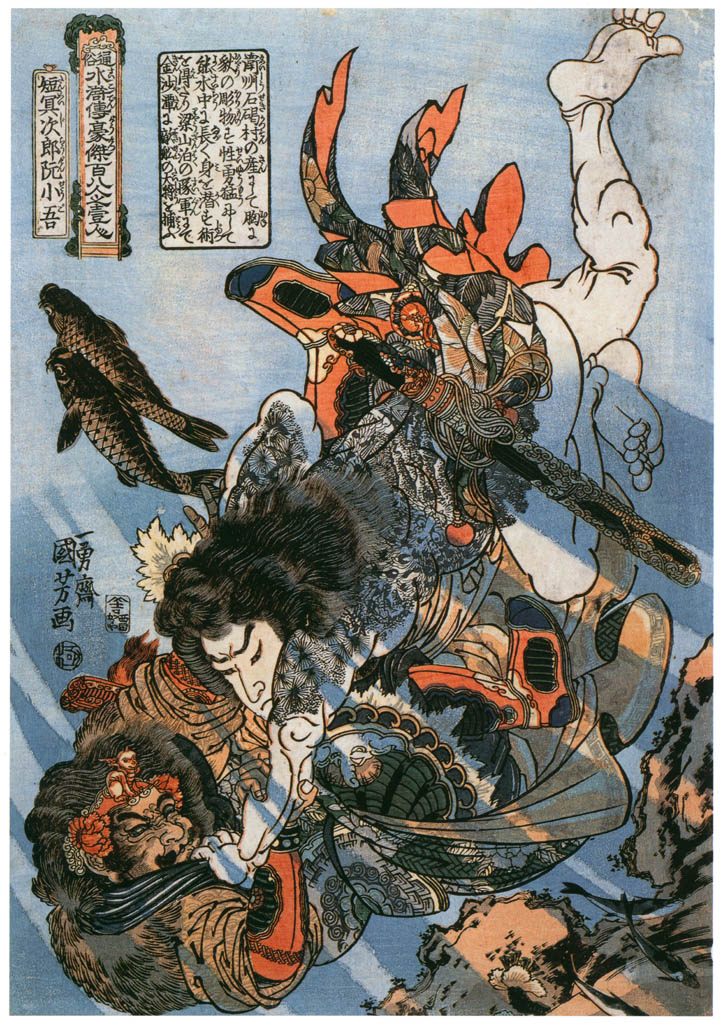
4. Kunisada Utagawa
Kunisada Utagawa (歌川 国貞) is an ukiyo-e artist who became famous for “bijin-ga” (美人画, paintings of a beauty). Actually, Kuniyoshi Utagawa and Kunisada Utagawa were fellow apprentices. Kunisada Utagawa’s ukiyo-e paintings became popular first, and Kuniyoshi felt disappointed when he found out about Kunisada popularity as he felt some superior feeling towards him Since then, these two painters became friendly rivals. In contrast to Kuniyoshi’s sturdy paintings of warriors, Kunisada’s paintings seem to have some elegance and grace. Even if you look closer to their paintings, you can see that Kunisada’s paintings have gentler colors than Kuniyoshi’s ones. Many ukiyo-e prints produced by these two rivals are recognized as outstanding masterpieces nowadays.
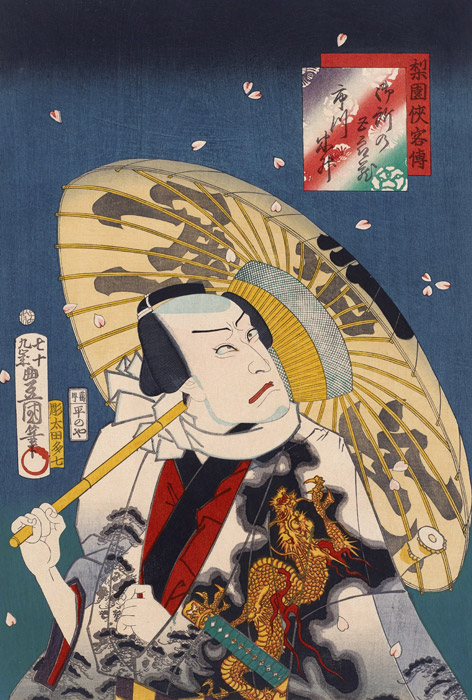
5. Sharaku Toshusai
Sharaku Toshusai (東洲斎 写楽) was an ukiyo-e artist who drew many portraits, known as yakusha-e portraits, of Kabuki actors who were active in the Edo period. However, he is still surrounded by mystery. Sharaku was literally “a dark horse” who suddenly appeared in the ukiyo-e world, unlike other ukiyo-e artists whose works were gradually recognized by people and gained popularity. It was an unheard-of début that Sharaku Toshusai, the completely unknown ukiyo-e artist, suddenly appeared there.
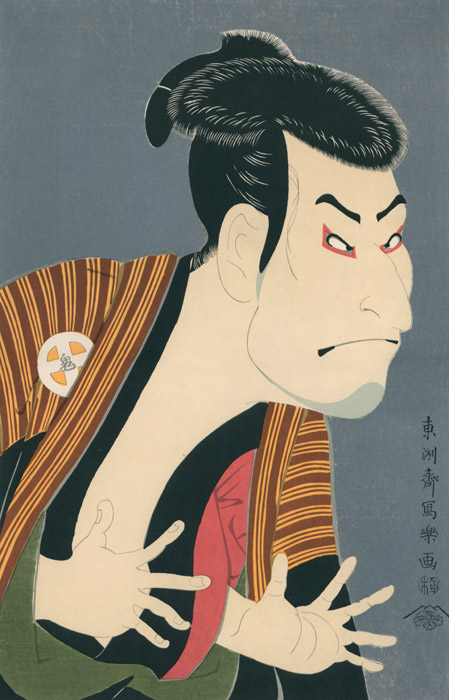
One of the most famous ukiyo-e paintings in the world can probably be this painting which portrays a Kabuki actor. By highlighting the contrast between the simple background color and the Kabuki actors’ portrait, you can feel the kabuki actors’ liveliness from this painting.
As suddenly as his uprise, Sharaku also suddenly vanished from the center stage of the ukiyo-e world in just about 10 months, leaving over 140 and a few works. Until today, his real name, who is was and how he was living is still unknown.
6. Hokusai Katsushika
The last name on the list is Hokusai Katsushika (葛飾 北斎), a world-famous ukiyo-e artist. Hokusai had the longest life among ukiyo-e artists, and he lived until he was 90 years old. Hokusai drew many ukiyo-e paintings with the theme of Mt. Fuji, as the series of “Fugaku Sanjyuurokkei” (富嶽三十六景, Thirty-six Views of Mt. Fuji). He started to draw this series after he was aged around 60. Hokusai had a very novel life. It is said that he had moved 93 times. Moreover, although he was a very popular ukiyo-e artist, he was always poor and he spent most of his money on purchasing coloring materials rather than clothing, food and shelter. He continued to paint until his death, leaving about 30,000 works!
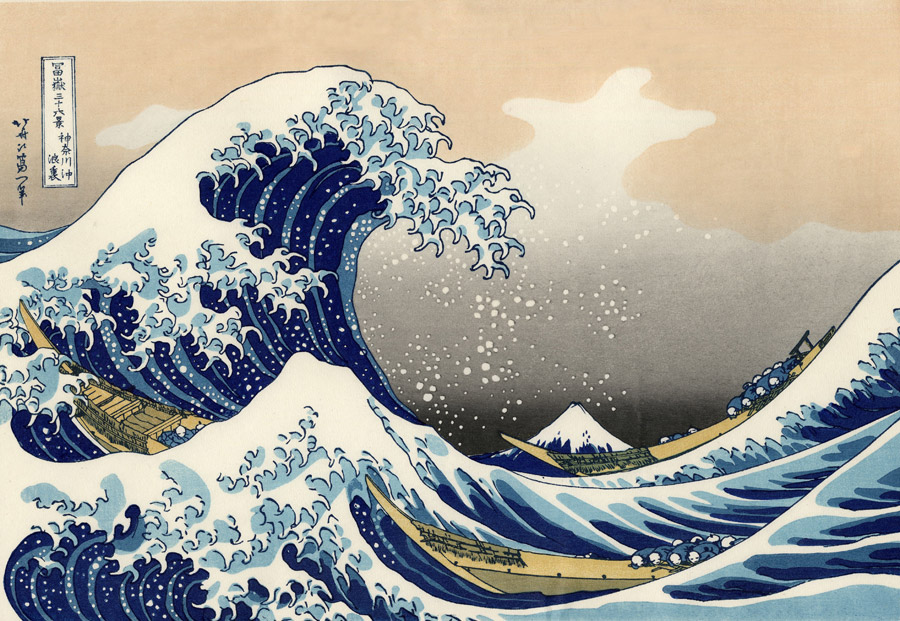
One of Hokusai’s most popular works is probably “Kanagawa okinami ura” (神奈川沖浪裏, The Great Wave off Kanagawa) from the series of “Thirty-six Views of Mt. Fuji”. By drawing Mt. Fuji in the back and rough waves in the foreground, the entire landscape is dynamically emphasized. It is exactly a gem of Hokusai’s work.
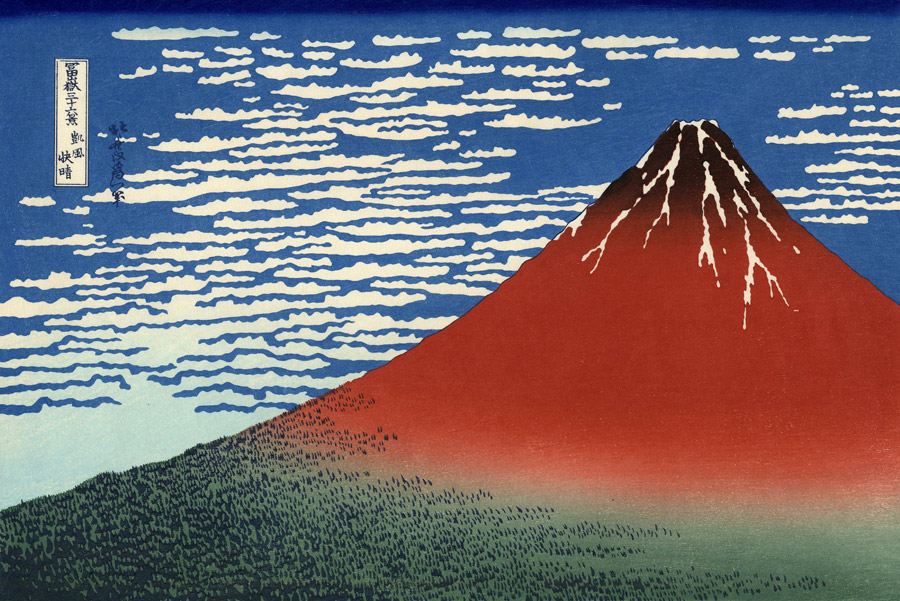
Another famous work by Hokusai is “Gaifū kaisei” (凱風快晴, Fine Wind, Clear Morning) from the same series. When drawing Mt. Fuji, usually it is painted in blue. However, in this painting Mt. Fuji is colored bright red. Therefore, this ukiyo-e is often called “Red Fuji” among Japanese people.
By the way, good news here for all Hokusai fans; if you would like to see more of his work you can visit the Sumida Hokusai Museum in Ryogoku, Tokyo. When you are interested, feel free to visit and explore the Hokusai world there.
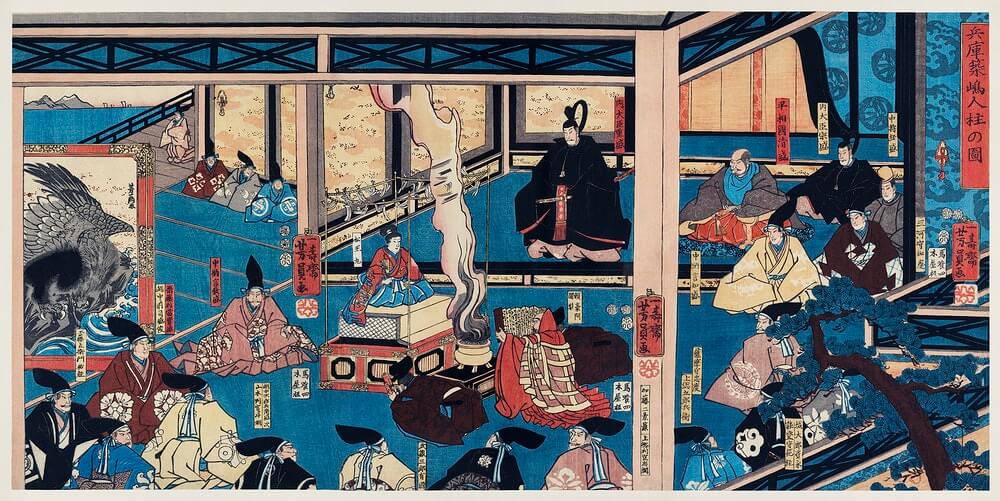
Here, we looked at various ukiyo-e artists and their famous works, but did you find your favorite ukiyo-e artist or work? It can be said that the appearance of Ukiyo-e paintings is a remarkable point in the history of Japanese art, since it enabled normal citizens to feel free to enjoy art culture in the Edo period. It has fascinated many people for centuries and has been highly appreciated not only in Japan but all over the world now. Ukiyo-e paintings are wonderful art that always inspires us.
Follow us on Instagram, Facebook and Twitter for more travel inspiration. Or tag us to get featured!
Happy travelling!
Other articles you may also like

Mao Goto is a Japanese freelancer who was born in Hayama, Kanagawa prefecture, and raised in Tokyo. Since 2016 she lives in the Taito Ward, home to a lot of Japanese culture hotspots such as Asakusa, Akihabara, and Ueno. She has been interested in the field of English education of Japan and got her Master’s degree in March, 2020. A lover of photography, travel, sweets, and cross-stitch. Contact her via Facebook.
This post may contain some affiliate links. When you click through and make a purchase we may receive some commission, at no extra costs to you.
